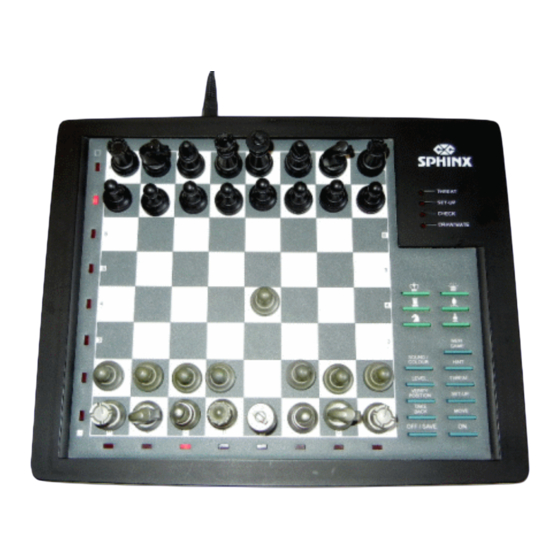
Summary of Contents for CXG Sphinx
- Page 1 User Manual SPI11 nx �X� Mode D'emploi Bedienungsanleitimg Manual De Instrucciones CiebruiksaanvrljzUng ©copyright National Telecommunication System Ltd. 1992...
-
Page 3: Table Of Contents
CONTENT 1. INTRODUCTION 2. STARTING PLAY 3. MAKING MOVES 4. CORRECTING ERRORS 5. SPECIAL MOVES 6. WARNINGS OF THREATS CHECKMATE- STALEMATE- NEW GAME INTERRUPTING THE COMPUTER- CHANGING SIDES LEVELS OF PLAY 10. TAKING BACK MOVES 11.PLAYING BOTH SIDES 12.CHECKING THE POSITION 13.SETTING UP A POSITION 14.SOUNDS 15.MEMORY... -
Page 4: Introduction
INTRODUCTION Your SPIDNX Chess Computer is an ideal opponent. It is ready to play you at any time, as often as you like, at whatever level of skill you choose. Using the machine is simple- you just move the pieces on the chessboard in much the same way as you would against a huma n player. -
Page 5: Correcting Errors
The machine "beeps", and two red lights come on- at the end of the rank ( or vertical column ) in which your piece is located. ( b ) Move your piece to the square where you want it to go, and press down with it again. -
Page 6: Special Moves
you make a mistake when carryin g out a The error signal is also heard move for the computer. Simply continue making the move as indicated by the lights. SPECIAL MOVES Captures: You carry out a capture (for yourself or the computer) just like any other move. -
Page 7: Checkmate- Stalemate- New Game
CHECKMATE- STALEMATE- NEW GAME If either player checkmates the opponent, all lights along the left-hand will edge of the board flash on and off. The machine similarly indicates stalemate by flashing all the lights along the bottom edge of the board. NEW GAME To start a new game, rearrange the pieces and press the key. -
Page 8: Levels Of Play
LEVELS OF PLAY The operating key marked LEVEL - which can be used any time when it is your turn to move - enables you to alter the speed and strength of the computer's play. When you press this key, the corresponding light on the control panel comes on. - Page 9 SQUARE THREAT AUTOMATIC LEVEL RESPONSE TOBE SIGNALS PRESSED y e s...
- Page 10 LEVEL SQUARE T HR E AT AUTOMATIC TOBE SIGN ALS RESPONSE PRESSED...
-
Page 11: Taking Back Moves
In the table, each square is identified by the letter of its rank and the number of its file. Looking at the board from White's end, the files range from "A" on the left to "H" on the right; the ranks range from at the "1"... -
Page 12: Playing Both Sides
You can now make another move in place of your last one. Alternatively, you can press TAKE BACK again and retract the preceding move. Up to eight "half- moves" (i.e. four moves for each side) can be taken back at any one time. - Page 13 As an example, suppose the position is as follow: BLACK WHITE To check the positions of the pawns, press the "pawn" key light at the end of third rank (the row of squares third from bottom) comes on, showing that this rank is the nearest one to White's end that has pawns on it.
-
Page 14: Setting Up A Position
) a third time, and the light for the sixth rank comes on, while Press (! ) the light for the "E" file blinks. If you press fourth time, squares will be indicated; this tells you that there are no pawns on th e board other than those demonstrated already (A fifth press of the "pawn"... - Page 15 We shall see from example how the alterations are made. The general idea is as follow. When you press on a �quare where a white piece is located, the computer assumes you are removing this piece and inserting a black one on the square instead. When you press a square containing a black piece, the computer assumes the square is being cleared..
- Page 16 Note that in SET-UP mode, just as in normal playing mode repeated presses on a "piece" key have the effect of demonstrating all the piece If you remove all pieces of the one type positions of the relevant type. from a particular rank, the lights change to show the next rank that contains such pieces - or, there are no such pieces present, the lights go no "piece"...
- Page 17 In connection with setting up positions, there are a few further points to be noted: CASTLING AND EN PASSANT If a king or rook has been placed on the board in the way we have just described, there can be no castling with that piece. To create king's side, press NEW GAME before SET-UP- then leave the king and king's rook undisturbed on their starti ng squares, while other pieces are removed and reinserted as necessary.
-
Page 18: Sounds
SOUNDS Press the sound key you prefer the computer to operate without its audio signals. The sounds can be switched on again by repressing the same key. MEMORY If a game in progress has to be interrupted, the computer can be switched off (see Section 16), and will retain the game position in its memory w�e using a minimum of curr e nt. - Page 19 ML0815900440-8...


Need help?
Do you have a question about the Sphinx and is the answer not in the manual?
Questions and answers